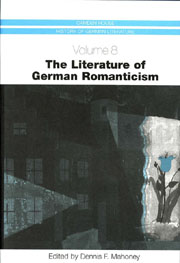Book contents
- Frontmatter
- Contents
- Illustrations
- Acknowledgments
- Abbreviations
- Introduction
- From “Romantick” To “Romantic”: The Genesis of German Romanticism in Late Eighteenth-Century Europe
- Goethe and the Romantic
- Early Romanticism
- From Goethe's Wilhelm Meister to anti-Meister Novels: The Romantic Novel between Tieck's William Lovell and Hoffmann's Kater Murr
- Tales of Wonder and Terror: Short Prose of the German Romantics
- The Romantic Drama: Tieck, Brentano, Arnim, Fouqué, and Eichendorff
- German Romantic Poetry in Theory and Practice: The Schlegel Brothers, Schelling, Tieck, Novalis, Eichendorff, Brentano, and Heine
- The Turn to History and the Volk: Brentano, Arnim, and the Grimm Brothers
- History and Moral Imperatives: The Contradictions of Political Romanticism
- Romanticism and Natural Science
- Gender Studies and Romanticism
- The Romantic Preoccupation with Musical Meaning
- Romanticism and the Visual Arts
- Goethe's Late Verse
- The Reception of German Romanticism in the Twentieth Century
- Works Cited
- Notes on the Contributors
- Index
The Reception of German Romanticism in the Twentieth Century
Published online by Cambridge University Press: 05 February 2013
- Frontmatter
- Contents
- Illustrations
- Acknowledgments
- Abbreviations
- Introduction
- From “Romantick” To “Romantic”: The Genesis of German Romanticism in Late Eighteenth-Century Europe
- Goethe and the Romantic
- Early Romanticism
- From Goethe's Wilhelm Meister to anti-Meister Novels: The Romantic Novel between Tieck's William Lovell and Hoffmann's Kater Murr
- Tales of Wonder and Terror: Short Prose of the German Romantics
- The Romantic Drama: Tieck, Brentano, Arnim, Fouqué, and Eichendorff
- German Romantic Poetry in Theory and Practice: The Schlegel Brothers, Schelling, Tieck, Novalis, Eichendorff, Brentano, and Heine
- The Turn to History and the Volk: Brentano, Arnim, and the Grimm Brothers
- History and Moral Imperatives: The Contradictions of Political Romanticism
- Romanticism and Natural Science
- Gender Studies and Romanticism
- The Romantic Preoccupation with Musical Meaning
- Romanticism and the Visual Arts
- Goethe's Late Verse
- The Reception of German Romanticism in the Twentieth Century
- Works Cited
- Notes on the Contributors
- Index
Summary
As an original, unique and undiluted, literary and cultural movement, German Romanticism did not last long: perhaps thirty years or so after its rise around 1795. Moreover, most of its creative, signature ideas had already been realized by the Early Romantics (Wackenroder and Tieck, the Schlegel brothers, Hardenberg-Novalis, Schelling, and Schleiermacher), and little of import emerged after the traumatic shock to the German collective mind occasioned by the battle of Jena-Auerstedt in 1806. That Romanticism should have earned one of the longest and weightiest reception histories of any such movement — until the present day — is thus eloquent testimony to its significance.
In what follows, the enormously widespread reception of German Romanticism in the last century will not be measured against any definition of today. What counts is not the current state of scholarship, which is well documented in the preceding pages, but the state of knowledge then: What the word Romanticism connoted within the contemporary horizon, which writers concerned themselves with Romanticism, which aspects they selected, how these were interpreted, what cumulative story about Romanticism all these episodes build up into. Romanticism (unlike, say, the Sturm und Drang) is not a purely literary phenomenon. It speaks in every medium of expression then available. Here however the literary reception is unashamedly the main object of interest. It will be explored in three sections: the literary image of Romanticism in high modernism around 1900, the Weimar Republic, and German literature after 1945 in both East Germany and the Federal Republic of Germany.
- Type
- Chapter
- Information
- The Literature of German Romanticism , pp. 327 - 360Publisher: Boydell & BrewerPrint publication year: 2003

